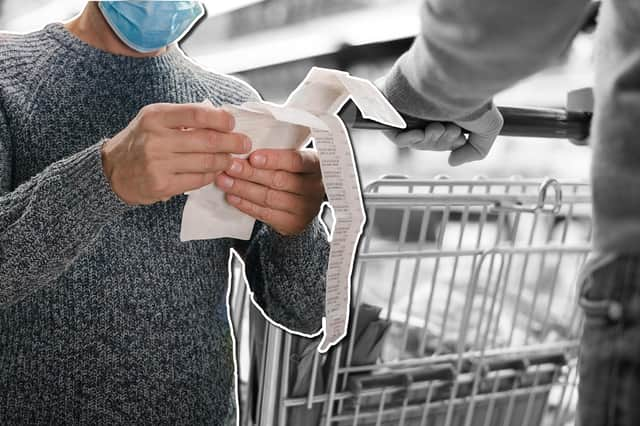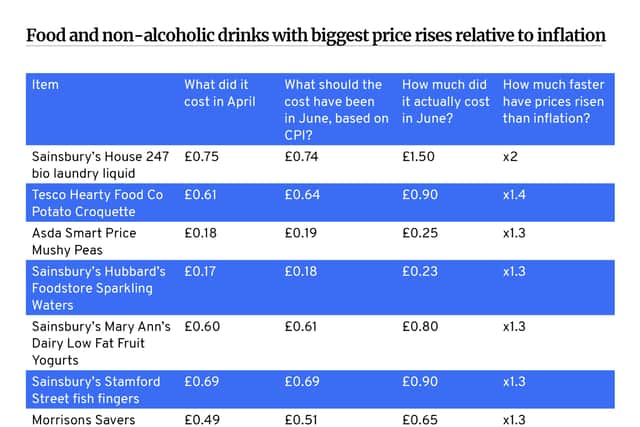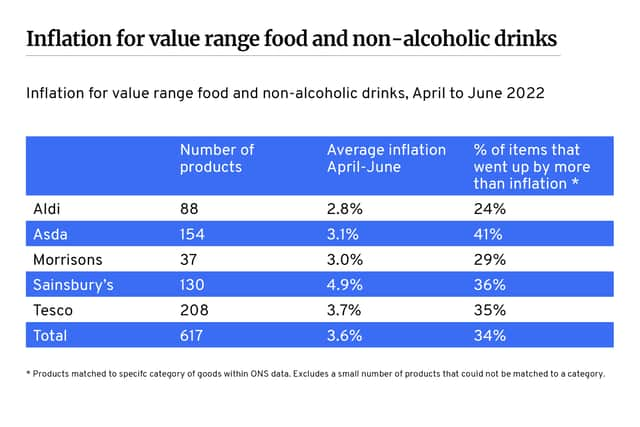Cost of living: supermarkets raised value range food prices faster than CPI inflation in April, May and June


UK supermarkets put up prices on their basic range food and drink products faster than the overall rate of inflation in the three months to June, NationalWorld can reveal.
Exclusive research has found prices for value range food and non-alcoholic drinks across five major supermarkets rose by an average of 3.6% between April and June.
Advertisement
Hide AdAdvertisement
Hide AdOffice for National Statistics (ONS) figures show the rate of inflation – as measured in the Consumer Prices Index (CPI) – stood at only 2.7% for the same goods during the period.
More than a third of items saw inflation-busting price rises, our figures show, with prices rising by around 30 times faster than inflation in some cases.
At Sainsbury’s alone prices rose by an average of 4.9% – around 1.8 times faster than inflation.
The analysis follows sustained criticism of the official cost of living measure’s ability to accurately reflect price rises faced by the poorest households, from campaigners including food writer Jack Monroe.
Advertisement
Hide AdAdvertisement
Hide AdExperts from the Food Foundation charity and the Institute for Public Policy Research’s Centre for Economic Justice have now warned of “dramatic” reductions in living standards and “severe hardship” in the winter ahead if action is not taken to reduce the rising cost of living.
How have prices for value range items changed?
NationalWorld has been taking monthly price snapshots of hundreds of basic range groceries at Aldi, Asda, Morrisons, Sainsbury’s and Tesco since April.
The items covered include basic own-brand products such as Asda Smart Price, Morrisons Savers and Aldi Everyday Essentials, as well as a collection of in-house tertiary brands that replaced the Tesco Value and Sainsbury’s Basics lines in recent years.
Last week we revealed how more than half of the products in our tracker had seen price hikes between April and August.
Advertisement
Hide AdAdvertisement
Hide AdThe latest ONS CPI inflation data covers to June, and shows food prices rose by an average of 3% while non-alcoholic drinks prices increased by 1% – giving a combined inflation rate of 2.7%.
Between April and June, we were able to gather price data for 587 value range food and 30 non-alcoholic drinks items from the supermarkets’ websites.
This showed prices rose by an average of 3.5% across food products, or 3.6% across food and drinks combined.
Four out of five of the supermarkets had a higher rate of inflation for food alone, with only Aldi coming in under the 3% rate, with an increase of 2.8%.
Advertisement
Hide AdAdvertisement
Hide AdFor food and drink combined, all five supermarkets had a higher rate of inflation compared to the CPI – although Aldi’s rate of increase was still 2.8%, just over the CPI rate of 2.7%.
We also matched 620 of the products to a specific category of goods within the ONS’s detailed CPI breakdowns (17 products were either not covered in the UK CPI, or could not be easily matched to a category, so were excluded from this part of our analysis).
This showed that a third of products (203) saw faster price rises compared with the rate of inflation for similar types of goods.
Sainsbury’s House 247 laundry liquid had the biggest disparity. The price doubled from 75p to £1.50, despite deflation of -1.8% across cleaning products as a whole.
Advertisement
Hide AdAdvertisement
Hide AdAt Sainsbury’s, Hearty Food Co frozen potato croquettes rose by 48%, from 61p to 90p. But inflation for potatoes – the category frozen potato products belong – stood at 5.6%. The croquettes would have cost 64p, if they had risen in line with inflation.


Which supermarkets had the biggest price rises?
Price rises at Sainsbury’s were the highest relative to inflation, according to our analysis.
Over the three-month period, food/non-alcoholic beverage prices rose by 4.9% compared to the 2.7% CPI, while food prices alone rose by 5.1% compared to average inflation of 3%.
Tesco had the next highest average price hike – 3.6% for food and drinks combined, or 3.7% for food alone.
Advertisement
Hide AdAdvertisement
Hide AdIn terms of the proportion of products that saw inflation-busting price rises, Asda performed worst, with 41% of products affected.


What do the experts say?
Isabel Hughes, policy engagement manager at the Food Foundation, said surging prices were putting household budgets under intense strain.
“‘The cost of living crisis doesn’t just mean that low-income households are buying fewer luxuries,” she said.
“More and more households are now unable to afford even essentials – food, let alone shampoo or washing powder.
Advertisement
Hide AdAdvertisement
Hide Ad“People are already facing severe hardship, and as winter approaches we’re facing an impending crisis which needs urgent attention and action.”
Shreya Nanda, economist at the Institute for Public Policy Research’s Centre for Economic Justice, said the cost of essentials had risen dramatically in recent months and is expected to rise more.
“Without further policy action, we can expect to see dramatic reductions in living standards for much of the population,” she said.
“Increased support, and action to increase energy production in the medium term, are critically needed to avoid this and end this crisis.”
‘Laser focus’ on price of the weekly shop
Advertisement
Hide AdAdvertisement
Hide AdNationalWorld approached Morrisons, Sainsbury’s and Tesco – where food inflation was highest – with a request for comment.
Tesco said it was “absolutely committed” to helping its customers and was keeping a laser focus on the cost of the weekly shop.
“We have significantly increased the number of value lines we offer and whether it’s price matching basics to Aldi prices, promising Low Everyday Prices on household staples, or offering exclusive deals and rewards through thousands of Clubcard Prices, we’re more committed than ever to providig our customers with great value,” a spokesperson said.
A spokesperson for Morrisons said: "We are working hard to support customers during this difficult time and within our entry level range, we are currently rebranding our fresh products into the Savers brand so they are easier for our customers to identify and purchase."
Advertisement
Hide AdAdvertisement
Hide AdA Sainsbury’s spokesperson said, “With costs going up, we are working hard to keep prices low.
“We are investing over half a billion pounds to ensure the items people buy most often are on the shelves at the best prices and we are confident our Sainsbury’s Quality, Aldi Price Match campaign and Price Lock promise are making a big difference to our customers.
“Our latest financial results show that we are putting up prices at a slower rate than our competitors and focus on offering customers the best quality and value food.
“In stores and online customers can now find new, low prices on everyday staples - from chicken breasts to mincemeat, butter, onions and strawberries.
“The bold steps we are taking to focus on value means all our customers will find great deals when they shop with us and do not need to go anywhere else to get the best prices on their weekly shop.”
Comment Guidelines
National World encourages reader discussion on our stories. User feedback, insights and back-and-forth exchanges add a rich layer of context to reporting. Please review our Community Guidelines before commenting.
